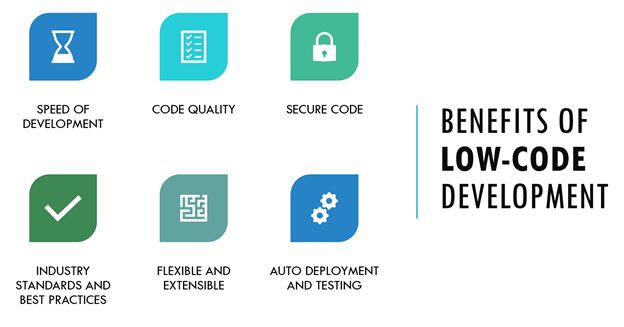Recommended Suggestions For Choosing Low-Code Platform Info
Wiki Article
Speed-Wise Low-Code Applications Have Many Advantages.
Visual Development Environment :
Drag-and-Drop Interfaces: Low-code platforms provide visual tools for designing applications. Drag-and-drop elements allow developers to quickly build applications without writing code.
Many low-code platforms include pre-built templates or components that allow developers to quickly prototype applications and build applications without starting from scratch.
Reduced Coding Requirements
Automated code generation: Low-code systems generate the underlying codes based on the visual models developed and maintained by developers. This eliminates the requirement for manual code coding and speeds up the development process.
Reusable Components: Developers may make use of reusable components across various projects, minimizing the time they spend creating and testing code.
Collaboration can be streamlined.
Integration of Development Tools: Low-code tools usually contain tools for managing versions testing, deployment, and testing, facilitating seamless collaboration among development teams.
Citizen Development - Business users, non-developers and other stakeholders can all help in the creation of applications by using user-friendly interfaces. This helps to reduce the bottleneck created by the inaccessibility of experienced developers.
Rapid Iteration, Prototyping:
Rapid prototyping: Developers can create quickly prototypes in order to collect feedback and confirm ideas, resulting in faster cycles of iteration.
Easy Modifications. The visual nature low-code development offers makes it easy to modify and update applications. This speed up the process of improving and refining the application in response to user feedback.
Pre-built Integrations:
API Integrations: Low code platforms usually come pre-built with connectors for popular services and APIs. This can reduce the time required to integrate other systems.
Data integration: Tools to integrate data are integrated to make it easier for the process.
Deployment & Scaling
One-Click Installation: Many low-code platforms have the option of installing with one click, reducing the amount of effort and time needed to set up applications.
Cloud-based Platforms: Cloud-based platforms that are low-code allow for the management of the infrastructure and scale, which means developers can focus on the logic and performance of their applications instead of deployment logistics.
The speed of low-code app development is in its ability to simplify and automate many aspects of the application development process. This facilitates faster delivery of applications as well as faster adaptation to changing requirements. Take a look at the most popular Low-code Platform for application development for website tips including paas service, application modernization software, rad development, rapid action development, rad application development, jdbc server, application modernization, rapid app development, rapid action development, azure sql and more.

Low-Code App Development Has Many Benefits In The Area Of Cost-Effectiveness.
Low-code application development offers numerous advantages when it comes to cost-efficiency and efficiency, which makes it an appealing option for businesses looking to reduce their development costs while delivering high-quality applications. The main benefits are reduced development costs
Lower Coding Requirement: Lower Coding platforms remove the need to code manually, saving developers both time and money. This translates to lower labor costs.
Less developers: Since low code development is faster and more simple, there are fewer specialized resources for developers required. This reduces the need for costs of recruiting and retaining personnel.
Faster Time To Market
Accelerated Development Cycle Visual tools for development and the pre-built parts offered by low-code platforms allow for rapid application development, which allows companies to get their products on the market more quickly. This could result in faster revenues and better standing in the market.
Rapid prototyping. Businesses can quickly test and develop prototypes. This reduces time spent during the development phase and allows for faster iterations that are based on feedback from users.
Lower Maintenance Costs:
Due to their modular structure and common components, low-code platforms usually make it easier to maintain applications. This helps reduce the cost of maintenance on a regular basis.
Automated updates: Many low-code platforms automate patches and updates, ensuring that applications are secure and up to date without the need for a lengthy manual intervention.
Efficient Resource Utilization:
Non-Developer Contributions: Low-code platforms allow people who are not developers to be part of the process of development. This democratization allows businesses to utilize the talents of many employees and reduce the dependence on high-paying programmers.
Improved Utilization of IT Resources: IT departments are able to concentrate on more strategic projects rather than being bogged down by routine tasks of development increasing overall productivity and efficiency.
The Scalable Pricing model
Subscription-Based Pricing: A lot of lowcode platforms are flexible and have subscription-based pricing plans that rise with usage. Businesses are able to adapt their spending according to their growth and needs, without incurring large upfront costs.
Pay-As-You-Go: A few platforms offer pay-as you-go options. This allows businesses to only pay for the resources they actually use. This is especially beneficial for startups and small-sized businesses that have limited funds.
Lowering Third-Party Costs of Software:
Low-code platforms usually come with functions that are integrated, eliminating the need to purchase additional software or tools. This could save you money on subscriptions and software licensing fees.
Pre-Built Integrations: The existence of pre-built integrations that integrate with the most popular systems and services reduces the need for custom development, saving both time and money.
Increased ROI
Increased Return on Investment Rapid development: By combining lower costs and a quicker time to market, businesses are able to get a higher return on investments (ROI).
Enhanced Agility: Businesses can quickly adapt to market changes and demands of their customers and ensure that they remain current and take advantage of new opportunities that arise.
Training costs are cheaper:
User-Friendly Interfaces: The simple, user-friendly interfaces of low-code platforms reduce the learning curve for new users, minimizing the need for extensive training programs.
Accessible resources Low-code platforms often have extensive tutorials, training materials, and community assistance and help, which can reduce the need for formal instruction.
Collaboration is streamlined:
Improved Collaboration Tool: The built-in collaboration tool helps improve collaboration and communication among team members. This leads to faster development processes and also reduces the cost of projects.
Unified Development Environment. An unified development platform helps reduce costs and streamline workflows by reducing the complexities of managing multiple tools.
Low-code development is cost-effective because it decreases maintenance and development expenses. It also speeds up the time to market and maximizes the use of resources. Pricing models are flexible. Low-code can provide significant financial benefits for businesses. Follow the recommended source for Enterprise application development with Low-code Platform for more info including application modernisation, application modernisation, jdbc server, develop mobile application, app modernisation, mobile app development platforms, rapid applications, cross platform app development, paas service, lowcode no code and more.

Benefits Of Low-Code Application Development In Collaboration And Workflow
It's a great option for companies looking to improve team efficiency as well as streamline processes and enhance collaboration. Here are the top benefits: Improved Collaboration Across Functions:
Unified Development Environment : Low-code platforms provide a unified, one-stop environment where team members can work together effectively including designers, business analysts, and stakeholders. This helps reduce the number of silos, and improves communication.
Visual Development Tools Low-code platforms are simple to use and have the drag-and-drop interface. This allows non-technical members of the team to take part in the development phase, which ensures that business requirements can be gathered accurately.
Advanced Communication
Real-Time Collaboration Many low-code platforms offer real-time capabilities, like commenting and editing simultaneously, or instant feedback. This enables constant communication and can help to reduce the amount of time spent in a back and forth discussion.
Shared Workspaces Teams can collaborate by sharing workspaces. These workspaces allow them to review, edit, discuss and collaborate on project elements.
A streamlined workflow management system:
Built-in project management tools: Lowcode platforms often come equipped with integrated tools that aid teams in planning, tracking, and directing their growth. This includes assignment of tasks, progress tracking, deadline management and much more.
Workflow automation: The automation of routine work, workflows, as well as other processes reduces the manual effort required and also eliminates errors. This lets teams concentrate on more valuable tasks and increases efficiency.
Speedier Iteration Cycles:
Rapid Prototyping Low-code platforms are ideal for quick prototyping. Iterative development is also feasible, allowing the team to test, develop and improve their apps within shorter time. This allows for quick feedback and improvement.
Support for Agile Methodologies: Using agile methodologies allows teams to be agile and work in sprints, and to continuously provide small amounts of functionalities, making it easier to respond to changes in requirements.
Accessibility for non-developers:
Citizen Development - Low-code platforms allow business users the ability to create and modify apps without coding expertise. This helps to reduce the burden on IT and development departments and lets them respond faster to the needs of business.
Training and Onboarding - Simple interfaces, comprehensive training resources and intuitive interfaces make it easy for new team members get up to speed and improve the overall team's cooperation.
Centralized Documentation & Knowledge Sharing
Integrated Documentation: Low-code platforms often include features to create and maintain documentation within the platform itself, ensuring that all project information is accessible and centrally stored.
Knowledge Repositories : Teams are able to create knowledge repositories. These include templates, best practices, and reuseable components. This allows for sharing of knowledge and reduces duplication of efforts.
Consistency and Standardization
Standardized Components. The use of standard components that are pre-built allows for uniformity throughout all software. This allows team members to understand and work with different parts of projects.
Governance and compliance Governance and compliance: Integrated governance frameworks ensure that development conforms to regulations and standards of the organization. This lowers the risk of non-compliance, as well as helping applications meet quality standards.
Feedback and Improvement Loops:
Integrated Feedback Mechanisms - Low-code platforms are often equipped with integrated feedback mechanisms. These enable users to give instant feedback on applications, which can later be used in the process of development.
Continuous Improvement - The capacity to rapidly iterate the deployment and modification of applications based on feedback from users allows them to be aligned with the business objectives and user demands.
Reporting and visualization:
Real-time analytics The built-in analytical and reporting tools provide real-time information about project progress, performances and user interaction. They facilitate an informed, data-driven decision-making.
Visual Workflow Analysis Visual tools are utilized to show workflows and processes. These tools aid teams to analyze and improve their workflows.
Low-code development of applications is an effective tool to collaborate and streamline workflow. It connects disparate teams, improves communication, and streamlines processes. This promotes a more agile, collaborative and efficient environment for development. This ultimately results in better-quality applications and better alignment of business goals.
